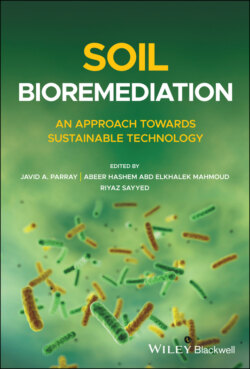Читать книгу Soil Bioremediation - Группа авторов - Страница 12
1.1 Introduction
ОглавлениеThe environment has been severely polluted with chemicals that are poisonous both to the environment and to human beings [1–3]. A polyphasic approach has been adapted to overcome the effect of these toxic pollutants that includes (i) stringent regulations for the production and usage of complex chemicals, (ii) the treatment and safe disposal of harmful chemicals, and (iii) the reclamation of polluted sites [4, 5]. The first two are defensive in nature and minimize damage to environment, while the latter is a restorative mechanism [6, 7]. The methods of bioremediation are used for (i) the conversion of highly toxic to less‐toxic substances, (ii) the mineralization of contaminants, and (iii) pollutant immobilization [8–12]. Microorganisms in general, and bacteria in particular, harbor enormous metabolic diversity, allowing them to utilize the complex chemicals as energy sources [11, 13]. Further, due to genetic evolution they attain a new metabolic potential to degrade newly added xenobiotic substances [13–15]. The other major focus area of bioremediation studies has been the characterization of metabolic pathways and their respective molecular regulations [16–18]. The advent of whole genome sequencing and related genomics methods has also given rise to new avenues for genome‐wide screening of degradative genetic elements and regulatory sequences among the pollutant‐degrading strains [19–22]. The main concerns for using isolated microorganisms are: (i) the portion of microorganisms may have substantial potential of degrading pollutants and (ii) true degradation of pollutants is not often a true reflection of the in‐situ bioremediation [23, 24]. The perfect bioremediation techniques need to be executed in such a manner that microorganisms counter a variety of biotic and abiotic factors [23–26]. These factors greatly affect the efficiency of bioremediation process through various mechanisms [27]. Numerous studies also suggest that these are not only the environmental factors but also the technological advances, which affect the process of bioremediation. From the above studies, a major area of environmental research has emerged that assess the eco‐sustainability of in‐situ bioremediation process. Furthermore, various programs are required to monitor and address the following uncertainties: the expected remediation of hazardous substances, the potential of microorganisms, and the adverse impact of remediation processes on various environmental factors [28]. Previously, only the kinetics of degradation was determined but, with the advancement of ecological techniques, community behavior has also been made mandatory for in‐situ bioremediation studies [29, 30].
The key target of a bioremediation technique is to improve the effectiveness of the restoration of contaminated sites in a cost‐effective and environmental‐friendly manner. There is no single technique for restoring contaminated sites but research on the basis of nature and type of pollutants has led to the development of new techniques. Autochthonous microorganisms present in polluted environments hold the key to solving most of the challenges associated with biodegradation and bioremediation of polluting substances [31] provided that environmental conditions are suitable for their growth and metabolism. Bioremediation is ecofriendly and cost effective, which offers major advantages of this process over conventional physical and chemical methods. The bioremediation process mainly depends upon the nature of the pollutant, which include: agrochemicals, chlorinated compounds, dyes, greenhouse gases, heavy metals, hydrocarbons, nuclear waste, sewage, and plastics. The nature, depth, and degree of contamination, location, and cost are considered in any bioremediation technique [32, 33]. Furthermore, O2 concentration, nutrient content, temperature, pH, and other factors also are very important in considering the bioremediation technique.
